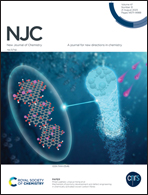Ni(ii)-polypyridyl complexes as potential DNA binders†
Abstract
Novel examples of homoleptic Ni(II)-polypyridyl complexes, 1–3, bearing six-membered chelate rings of aliphatic and aromatic backbones were synthesized. The presence of unpaired electrons in the complexes was evident by the chemical shift of protons stretched over −5 to 75 ppm in 1H NMR spectroscopy. In electrochemistry, the complexes showed low positive E1/2Ox values due to the strong σ-donating nature of the ligands and the high degree of metal–ligand interaction. Molecular docking showed that the synthesized homoleptic Ni(II)-polypyridyl complexes bound very strongly at different grooves of the DNA. While complexes 1 and 3 exhibited binding at the minor groove of DNA with a high number of non-bonded interactions with the nitrogenous bases and phosphate groups, complex 2, on the other hand, with a relatively lower number of non-bonded interactions, was found to bind preferentially at a major groove and at a perpendicular orientation of the axis of the DNA. The docking studies were further supported by UV-vis spectral changes of 1–3 upon titration with incremental volumes of DNA in phosphate buffer solutions. Among various possible binding conformations, each complex displayed a stable groove-binding energy in the range of < −7 kcal mol−1.



 Please wait while we load your content...
Please wait while we load your content...